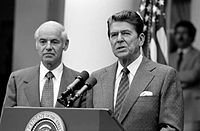August 1981 strike
On August 5, following the PATCO workers' refusal to return to work Reagan fired the 11,345 striking air traffic controllers who had ignored the order,[6][7] and banned them from federal service for life (this ban was later rescinded by President Bill Clinton in 1993).[8] In the wake of the strike and mass firings the FAA was faced with the task of hiring and training enough controllers to replace those that had been fired, a hard problem to fix as at the time it took three years in normal conditions to train a new controller.[2] They were replaced initially with nonparticipating controllers, supervisors, staff personnel, some nonrated personnel, and in some cases by controllers transferred temporarily from other facilities. Some military controllers were also used until replacements could be trained. The FAA had initially claimed that staffing levels would be restored within two years; however, it would take closer to ten years before the overall staffing levels returned to normal.[2] PATCO was decertified on October 22, 1981.[9]
Some former striking controllers were allowed to reapply after 1986 and were rehired; they and their replacements are now represented by the National Air Traffic Controllers Association, which was organized in 1987 and had no connection with PATCO.

